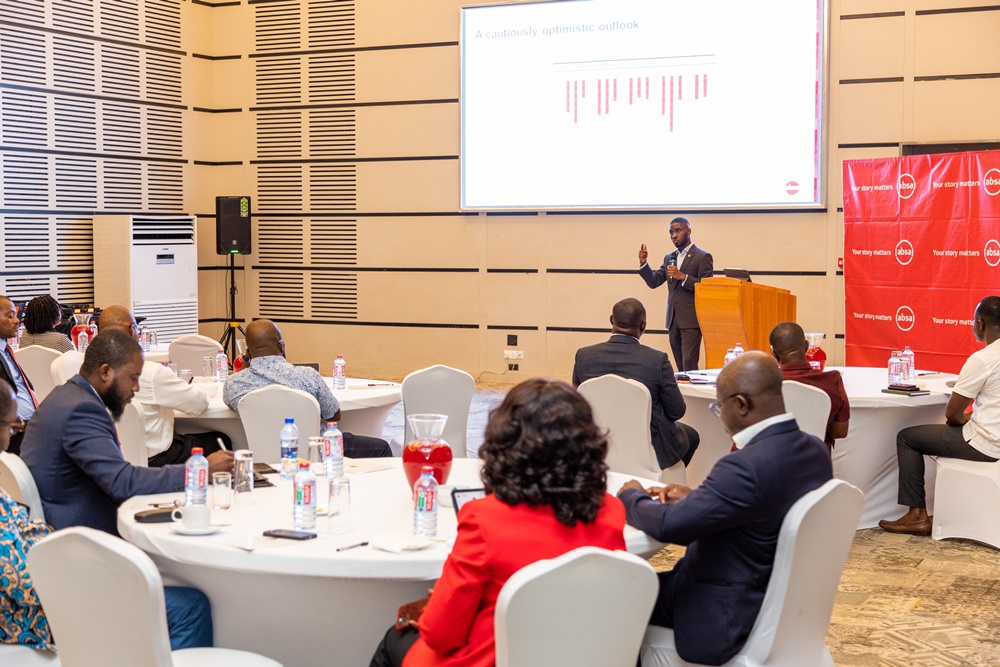
By Francis OWUSU-ACHAMPONG, FCIB
The last article on this subject emphasised the primacy of capital and liquidity in determining how far a bank could go in its objective of expanding credits, branch network expansion, increasing fixed assets acquisition or generally pursuing any strategic initiatives towards incremental profits.
It was noted, per the formula for determining the capital adequacy ratio that this must not fall below the prudential limit of 10%, plus a buffer of 3%, unless the bank has obtained a temporary Special Dispensation Authority from the regulator.
It is also noteworthy that the regulator is currently examining the capital restoration plans submitted by the respective commercial banks, following the distortions caused to their balance sheets by the DDEP measures.
A brief description of the elements in the formula would illuminate what could cause a bank’s CAR to rise or fall. Then a brief discussion about whether it is prudent to hold a higher ratio beyond the mandatory limit or industry average and also whether this augurs well for a bank’s push for optimal returns will follow.
Banking remains one of the most highly regulated sectors in any economy in view of its special role as a catalyst for development. Room for excessive speculation or reckless pursuit of risk in anticipation of fantastic returns, is scrupulously delineated by regulation. Regulatory focus to stem excessive risk taking is more robust and intrusive now in view of past experiences with failed financial institutions.
Implications for maintaining high or low capital adequacy ratio
A Capital Adequacy Ratio below the regulatory minimum of 13% is obviously a breach for which a bank may be penalized, given stern warnings to regularize within defined timeframes or, in extreme cases, face a licence withdrawal.
This was the case of some of the Ghanaian banks that collapsed in 2019 with NEGATIVE CAR exceeding 100 %, but some of whose directors still cried foul over perceived political persecution.
A higher capital adequacy ratio beyond the mandatory limit or industry average may connote a risk aversion or a tactical board decision to patiently look for opportunities to exploit. On its own, an excessively high ratio does not generate optimal returns and may run counter to the broad objective of maximizing returns.
This must, however, be contextualized within the framework of a short- or medium- term strategy and may not be considered bad, per se. A slim margin above the regulatory threshold for a limited period, could be a strategic decision to exploit a non- recurring opportunity.
This could be understood where the bank can leverage on its niche internal or hired expertise to ring fence inherent operational, liquidity and market risks embedded in the specific pursuit. It is the persistent holding of such posture over a long period that may give rise for concern.
This brings into sharp focus, the difference between the regulatory capital and economic capital that was alluded to earlier. The board’s focus must always be on meeting the regulatory capital within the prescribed cycle set by the regulator, failing which it may face sanctions, including direct penalty or a directive to freeze further loan expansion, suspend some exotic product introduction or other fixed assets acquisition.
The economic capital which is internally driven but still based on the same formula, therefore, becomes a threshold or benchmark that the board considers comfortable to hold, while ensuring that it MUST never be lower than the regulatory capital.
Equity (Tier 1) Permissible Reserves Tier 2 (Eligible Surbordinated Debt capital)
Risk Weighted Assets (RWA) Provisions for Market, Operational Risks.
For clarity, equity in the above formula, refers to the original capital contributed by the bank’s shareholders. Permissible reserves are usually profits held back from distribution to the shareholders or retained profits over the years or some other capital conservation buffer imposed by regulation.
The expression “permissible reserves” here connotes other reserves that the central bank may allow for capital computation purposes. This may include revaluation reserves and others, provided the regulator approves the purpose and mode of calculation.
This serves to solidify the capital base and serves as a cushion against losses in the future. It creates some resilience as far as risk appetite determination is concerned; creating room for big ticket asset creation to bolster profit generation and ultimate bank sustainability.
Capital could be supplemented by debt or funds provided by other financial institutions like the International Finance Corporation of the World Bank or other institutional investors on fairly long- term basis and against terms and conditions acceptable to the regulator particularly its tenor, clarity of interest determination and covenants against impromptu withdrawal.
A charge is also made for the potential susceptibility to operational risks arising from the people, systems, processes and external events. Another charge is made for potential risks emanating from the peculiar structure of assets and liabilities and the extent to which these could create risks due to the variabilities in interest and exchange rates movements.
Regulatory capital connotes a prudential requirement imposed on Banks by Ghana’s Banks and Specialised Deposit Institutions Act 2016 (Act. 930) This capital is a measure of the adequacy of a bank’s cushions against financial losses and routine business operations. It must not fall below 10%.
Risk Weighted Assets represent total advances, less actual Non- Performing Loans and a factor for probability of default.
Regulators in different jurisdictions determine what constitutes eligible capital and also the measures adopted for discounting or risk weighting specified Loans and Advances.
Depending on what the central bank perceives as risks to a particular bank’s loans portfolio, ie its quality, it may apply its own measure in determining the discount factor to arrive at a risk-based value for the entire asset portfolio. The resultant effect could be a lowering of the CAR which will then come with stringent regulatory directives on how to restore normalcy.
A high or low capital adequacy ratio in the context of mandatory holdings of raw capital and liquidity plays a crucial role in whether a bank finds it comfortable to play around their own assessment of what constitutes optimal capital. It also indicates how long a board considers it necessary to stay within defined capital adequacy bands, and the influence this positioning has on its profit generation capacities.
Economic capital is an internally derived measure of the capital required to support the inherent business risks to an active bank is exposed to. This measure is a capital level chosen by the Board to cover the bank’s losses or exposures with a certain probability or confidence level.
It is thus a ratio which the bank internally computes as being “adequate” for its internal evaluation purposes and may not be lower than regulatory capital.
An optimal regulatory capital for a typical commercial bank in Ghana must reflect these criteria;
- meet the regulator’s requirement and leave a buffer. (minimum 10% 3%)
- must be dependent on the bank’s risk profile- the quality of its loan portfolio, the businesses this portfolio is spread across, and the specific risks associated with the individual sectors it is exposed to.
- take cognizance its market share and what their peer group’s risk indicators are.
A bank’s Asset and Liability Management Committee (ALCO) is charged with the responsibility to align the bank’s strategy to existing or potential resources at the bank’s disposal and how to ensure the finest balance between liquidity and profitability.
Ambition is a necessary driver for superlative performance in every human endeavour. The desire for achievement naturally spurs individuals, businesses, and governments towards the realization of their ambitions, hence the varying degrees of risk acceptance or aversion.
Bullishness in banking expressed in an inordinate quest to grow too rapidly, is however tempered by the need to operate within clearly defined prudential measures, failure of which may draw the wrath of regulators.
What constitutes excessive ambition is however relative to the strengths and resources available to those charged with the responsibility to achieve certain goals within specific time frames.
It is important also to underscore the fact that modern banking should never be equated to gambling or running a casino. This fact underlies why banking is so heavily regulated with obligations to operate within prudential limits like the single obligor limit where a bank is not supposed to lend more than 25% of its equity to a single entity; not to invest more than 25% of its equity in fixed assets, hold prescribed percentages as primary reserves, among a host of other carefully selected and necessary constraints on speculative activities.
Banking, by nature, has very little room for excessive speculation driven from a thirst for high- risk appetite. Thus, some two decades ago, in response to an Africa-wide expansion strategy, then Barclays Bank (Absa) went into a massive expansionary mode, opening new branches in visibly unviable areas across its franchises in Africa.
That strategy was to cost them significantly and led to a hurried closure of most of these branches subsequently. The collapsed Biege Bank in Ghana also exhibited similar traits with a multiplicity of branches that failed to recognize that modern banking does not necessarily thrive on brick and mortar, but on technological supremacy and strategic collaborations. That accounted in large part to the liquidity crises that be-devilled the bank and leading to its demise.
Scanning the corporate dashboard of most of the 23 Ghanaian commercial banks, one finds a refreshingly new breed of board chairpersons and chief executive officers with admirable qualifications and the advantage of youthful energies.
These executives have onerous responsibilities to deliver optimal returns to their appointing authorities against the backdrop of an economy gravely battered by internal and external forces and just about recovering with resource infusion marked by tough conditions.
Realistically, the economy is yet to diversify significantly to the point where bank risk takers can boldly exercise their appetite without burning their hands.
With a Debt to GDP ratio hovering over 80 %, inflation down but still high in comparison with African peers and exchange rates responding grudgingly to unrelentless motherly cuddling from Bank of Ghana, an aggressive risk appetite posture in the medium term may appear challenging.
When you encounter a bank CEO who is persistently bullish in the market without reference to available capital, human resource endowment, the strength of the competition and the trajectory of government economic policies, run for cover! Such high- risk appetite may plunge the bank into bankruptcy, if the board does not apply the necessary levers timeously.
Examples of such persons or boards making such catastrophic mistakes are legion. Nick Leeson and the collapse of Barrings Bank is perhaps the biggest lesson in financial history. Here, analysts recall among multiple lessons, that uncontrolled risk appetite, even if this generates immediate returns, cannot be sustained indefinitely.
Unbridled risk appetite equally underlined most of the factors that led to the American financial crises of 2008-2010, the collapse of Sillicon Valley Bank and Wells Fargo, both in the US a few months ago.
The fall of some Ghanaian banks where a CEO is noted to have bragged about an ambition to own 25% of the pharmaceutical market without any personal expertise in that industry beyond his short stint in banking, is a sharp reminder of mal-aligned risk appetite.
Even more incredulous was the fact that the bank was operating with extended liquidity assistance from the central bank. In another instance, even liquidity support was drawn to establish other firms beyond the regulator’s jurisdiction.
Misdirected risk appetite equally became the bane of other CEOs, who, even as their banks were sinking in negative capital adequacy ratio, were still siphoning their banks’ funds into projects unrelated to the banks’ core mandate and internal competencies.
These examples should serve as a strong signal to local bank board members to consider their oversight responsibilities with utmost due diligence. Under new corporate governance rules, board members may be fired, fined or even jailed for failure to provide sufficient and timely risk oversight of their institutions.
This is the time for strong bank board of directors to ensure that prudence and conservatism prevail and any accounting gymnastics aborted. Executive profit- sharing schemes, though well-intended, can also motivate greed , recklessly high risk appetitie and less than full disclosures, often hidden in creative accounting practices.
While prospects still abound for selected individual banks, it is worth emphasizing that aggressive risk appetite cannot be pursued in a vacuum.
This write-up must not be construed as suggesting a high -risk aversion posture. It is just illuminating the fact that banking business is unique and must be conducted with prudence and conservatism, especially in an economy just recovering from the turmoil of the last two years.
Unbridled expectations, especially when these are tied to executive remuneration packages have a tendency to breed irresponsible corporate behaviour. This includes manipulation of financial statements, with or without the connivance of external auditors, as have happened before.
The writer is a Fellow of the Chartered Institute of Bankers, a former adjunct Lecturer at the National Banking College, a farmer and the author of “Risk Management in Banking” textbook.
Email; [email protected] Tel. 0244 324181
The post Banks and risk appetite determination (2) appeared first on The Business & Financial Times.
Read Full Story

























Facebook
Twitter
Pinterest
Instagram
Google+
YouTube
LinkedIn
RSS